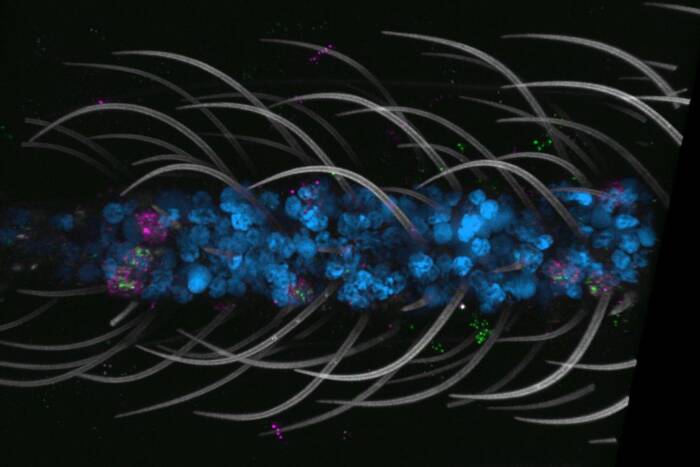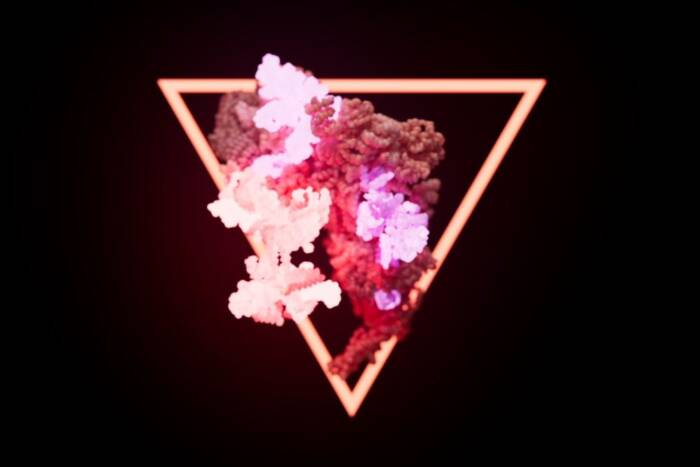Researchers unearth unusual enzyme lacking genetic code
“Brute force biochemistry” still required to isolate novel proteins

While isolating LPXTGase – an unusual enzyme lacking a genetic code – Rockefeller University professor Vincent Fischetti's team discovered a natural inhibitor capable of destroying several infectious microbes. As the above electron micrograph of streptococci bacteria (right) shows, the inhibitor causes many bizarre abnormalities, including asymmetrical cell division planes, not seen in normal bacteria (left).
Since their fiery beginnings on earth over three billion years ago, bacteria have evolved some unusual strategies for dealing with the problems of life, a kind of odd bag of tricks specialized for survival. The most recent idiosyncrasy to surface, which was discovered by Rockefeller researchers, is an essential protein lacking a genetic code.
Normally, in bacteria and all other types of living cells, proteins are assembled according to DNA codes written in genes. Tiny cellular machines called ribosomes determine a given protein’s amino acid sequence by reading a template derived from the gene that codes for the protein.
But in 1965, scientists discovered an exception to this rule: peptide antibiotics — short, complex proteins secreted by bacteria and fungi to kill rival cells — are manufactured solely by enzymes; their amino acid sequences are not spelled out by a genetic code.
Now, for the first time, Rockefeller University professor Vincent Fischetti and his colleagues Sung Lee and Vijaykumar Pancholi have discovered an essential group A streptococcal enzyme also lacking a corresponding gene. This enzyme, called LPXTGase, attaches surface proteins to a bacterium’s cell wall.
The finding is remarkable because it represents the first time that nonribosomal amino acid synthesis has been linked to such a large, and essentially much smarter, protein.
“It took us four years to identify this protein because we were looking for its gene,” says Lee.
Fischetti adds, “This completely changes the way we will look for new proteins in the future. Scanning genomic databases may not be enough to identify a potential enzyme. Instead brute force biochemistry may be required.”
The findings have immediate implications for the development of novel antibiotics. In addition to LPXTGase, the researchers discovered a natural inhibitor of this enzyme, and showed that it could readily kill strains of strep as well as staphylococci and enterococci bacteria, the culprits behind most hospital and nursing home infections. Staphylococci and enterococci are particularly dangerous because they have developed resistance to many traditional antibiotics. Drugs derived from this LPXTGase inhibitor might therefore constitute an alternative approach to treating these and other resistant infections.
“This inhibitor works on a totally different level from traditional antibiotics and thus may represent a viable alternative to treating multidrug resistant infections,” says Fischetti, who heads Rockefeller’s Laboratory of Bacterial Pathogenesis.
The findings were published in the Dec. 6, 2002 issue of Journal of Biological Chemistry.
Targeting weapon systems
Strep and other “gram-positive” bacteria, such as staphylococci and enterococci, are sheathed in a coat of arms — a thick cell wall dotted with surface proteins designed to interact specifically with human cells as a first step towards establishing infections. Without this outer weaponry, gram-positive bacteria could not invade people’s throats, skin and other susceptible tissues. Says Fischetti, “Naked bacteria cannot cause disease.”
Consequently, in 1990, Fischetti and colleagues set out to learn more about this potential vulnerability in bacteria. By understanding how cell surface proteins are attached to the cell wall, the researchers hoped to ultimately come up with new strategies to disarm the infectious microbes. What they discovered was a simple, protein-anchoring system.
It turns out that nearly all cell surface proteins on gram-positive bacteria contain a tag of five amino acids at their tail end, abbreviated LPXTG, which can be hooked directly into the cell wall. All that’s required to activate these hooks are special enzymes, one of which was discovered in 1999 by Fischetti’s former postdoctoral student, Olaf Schneewind, now a professor at the University of Chicago. Called sortase, this enzyme cleaves the LPXTG motif near the middle before linking the remainder of the protein to the cell wall.
No gene to guide them
But the story does not end with sortase. Beginning in 1998, Fischetti’s team, led by Lee, had set out on their own hunt for LPXTG-cleaving enzymes. Now, four years later, the researchers have finally found what they were looking for: a novel type of sortase later named LPXTGase. The hold-up? This enzyme had no corresponding gene.
“We were not expecting this at all,” says Lee, “What started out as a simple enzyme purification and characterization exercise turned out to be a major brute force biochemical problem.”
Coincidentally, Lee, a senior research associate, had taken part in pioneering work on nonribosomal peptide synthesis back in the early 1970s as an assistant professor in the laboratory of former Rockefeller professor Fritz Lipman. Were it not for Lee’s knowledge in this field, LPXTGase might still be going about its business in secrecy.
Another surprise to emerge during the isolation of the enzyme was its natural inhibitor. When the researchers applied this inhibitor to growing bacteria, several bizarre abnormalities including cell wall deformities — and eventually death — resulted. This finding confirmed that LPXTGase is essential for the bacteria’s survival and also indicated that LPXTGase plays a role in both anchoring surface proteins and cell wall assembly.
Further experiments with the LPXTGase showed other unusual traits. The enzyme is coated in a large number of sugars — an oddity for bacterial proteins — and possesses a high number of “unusual” amino acids. In addition to the standard 21 amino acids, bacteria harbor 20 unusual ones commonly associated with nonribosomal peptide synthesis.
But the real mystery is why the bacteria would opt for such an extravagant LPXTG-cleaving enzyme. To make this one enzyme, the bacterial cell must manufacture several others to build it – a much less efficient process than traditional protein synthesis. “The bacteria invests a lot of resources into making this enzyme, and we’re not sure why,” says Lee.
Adds Fischetti, “There are many questions remaining. Is this enzyme one-of-a-kind in bacteria, or are there others like it hidden in the many bacterial genes for which we have no function? And does this enzyme represent primordial protein synthesis, or do mammalian cells possess similar enzymes that we just haven’t found yet? We don’t have the answers, but will enjoy seeking them out.”


